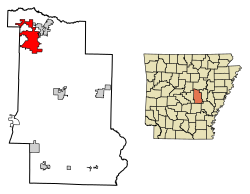Cabot, Arkansas | |
|---|---|
 Location in Lonoke County, Arkansas | |
| Coordinates: 34°58′22″N92°1′20″W / 34.97278°N 92.02222°W | |
| Country | United States |
| State | Arkansas |
| County | Lonoke |
| Founded | 1873 |
| Incorporated | 1891 |
| Area | |
| 20.78 sq mi (53.82 km2) | |
| • Land | 20.68 sq mi (53.57 km2) |
| • Water | 0.097 sq mi (0.25 km2) |
| Elevation | 299 ft (91 m) |
| Population (2020) | |
| 26,569 | |
• Estimate (2024) | 27,575 |
| • Density | 1,284.6/sq mi (495.99/km2) |
| • Metro | 685,488 (Little Rock) |
| Time zone | UTC-6 (CST) |
| • Summer (DST) | UTC-5 (CDT) |
| ZIP code | 72023 |
| Area code | 501 |
| FIPS code | 05-10300 |
| GNIS feature ID | 2403962 [2] |
| Website | www |
Cabot is the largest city in Lonoke County, Arkansas, United States. As of the 2020 census, the population of the city was 26,569, [3] and in 2024 the population was an estimated 27,575, [4] ranking it as the state's 19th largest city, behind Jacksonville. It is part of the Little Rock-North Little Rock-Conway metropolitan area.




